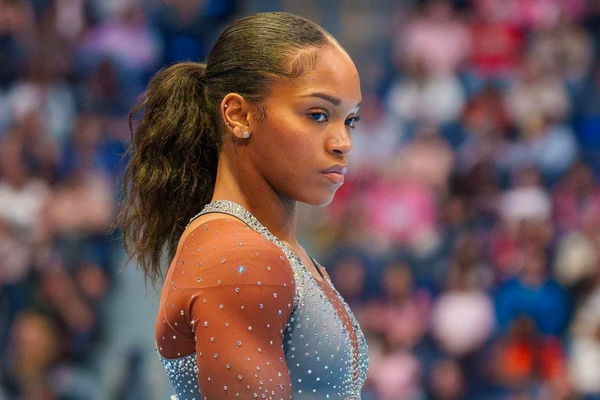

This year’s U.S. Classics competition was plagued with unfortunate incidents, earning it the moniker of being “cursed.” Notably, Gabby Douglas experienced two falls on the uneven bars, while Konnor McClain suffered an Achilles injury during floor warmups. Speculation among fans arose, with some questioning, “So, there were a lot of odd mistakes on bars. Coincidence? Something weird with the bars?“. However, clear answers remained elusive until recently. The competition was ultimately won by Simone Biles, with Shilese Jones securing second place. In a recent exclusive interview with EssentiallySports, Shilese Jones’ coach shed light on the events, potentially offering insights into the peculiar occurrences of the competition.
Watch What’s Trending Now!
Sarah Korngold, the head coach of Shilese Jones recently sat down for an exclusive interview with EssentiallySports, hosted by Shreya Verma, a content strategist at EssentiallySports and a national-level pistol shooter with a deep passion for gymnastics. During the interview, Verma, approaching the topic of the recent events surrounding core hydration. As Verma puts it, “A lot of fans interestingly thought the bars were a little cursed because you know, so much was happening on the bars. So, you know, a lot of fetishes were getting affected. But on the other hand, we saw Biles, and Jordan Chiles do so well. So do you think it’s cursed or it’s just, you know, it’s just a coincidence that happened?”
ADVERTISEMENT

To this, Sarah Korngold shared an insightful answer in the exclusive interview for EssentiallySports. She provided a detailed account of the equipment setup, stating, “I think it was just a coincidence. We measured the bars when we got there… a lot of the coaches have like little laser measures… they were totally within the frame.” Her explanation highlighted the precision and attention to detail involved in ensuring the apparatus met the required standards. Additionally, Korngold elaborated on the tension adjustment process, noting the use of a tension meter to fine-tune the equipment for optimal performance.
ADVERTISEMENT
Furthermore, Korngold delved into the broader contextual factors that could have influenced athletes’ performances. She acknowledged the challenges posed by strenuous travel schedules, stating, “Some people had really tough travel days.” For instance, Gabby Douglas experienced canceled air tickets and had to book a private jet. She arrived just a minute before podium training began. This acknowledgment underscored the significance of external factors beyond just the equipment itself.
Moreover, Korngold contextualized the event within the broader Olympic year, recognizing it as “the first big meet of the Olympic year.” This insight highlighted the added pressure and importance of the event in the athletes’ preparations for the upcoming Olympic Games. Additionally, Korngold noted the departure from the usual routine of two workouts, emphasizing how this alteration might have impacted athlete readiness. Despite these multifaceted challenges, Korngold reiterated her confidence in the equipment’s reliability, stating, “The equipment in my opinion was fine.” Her comprehensive analysis provided a nuanced understanding of the event. But these injuries were not just limited to U.S Classics.
ADVERTISEMENT
Incidents during podium training at Xfinity Championship
Before the Xfinity championship, which commenced on May 30th, a startling incident occurred during podium training. Colt Walker, while dismounting from the high bar, experienced a dramatic mishap as the bar snapped in half. Despite taking a nasty fall, Walker fortunately appeared to be uninjured afterward. Prompt action was taken to replace the damaged bar, ensuring the smooth continuation of the competition.
In the junior men’s championship of the same event, 16-year-old gymnast Danila Leykin encountered a challenging fall early in his parallel bars routine. Despite attempting to soldier on after re-chalking, it became evident that something was amiss with his wrists, leading him to exit the podium. Similarly, in the same event, Anthony Ruscheinsky also faced a fall, adding to the event’s unpredictability and the resilience required in high-stakes gymnastics competitions.
ADVERTISEMENT
ADVERTISEMENT
ADVERTISEMENT
ADVERTISEMENT

